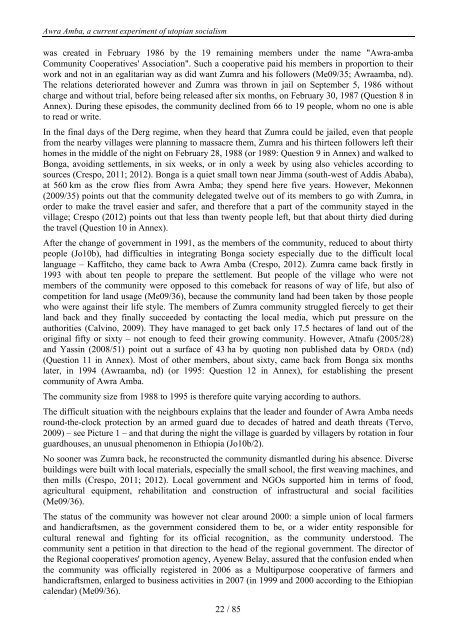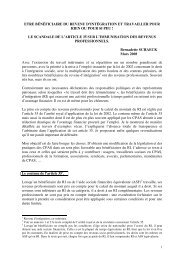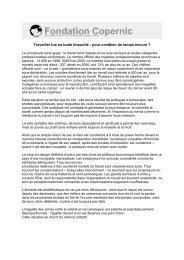Awra Amba RJ 300612 EN - Contacter un comité local d'Attac
Awra Amba RJ 300612 EN - Contacter un comité local d'Attac
Awra Amba RJ 300612 EN - Contacter un comité local d'Attac
Create successful ePaper yourself
Turn your PDF publications into a flip-book with our unique Google optimized e-Paper software.
<strong>Awra</strong> <strong>Amba</strong>, a current experiment of utopian socialism<br />
was created in February 1986 by the 19 remaining members <strong>un</strong>der the name "<strong>Awra</strong>-amba<br />
Comm<strong>un</strong>ity Cooperatives' Association". Such a cooperative paid his members in proportion to their<br />
work and not in an egalitarian way as did want Zumra and his followers (Me09/35; <strong>Awra</strong>amba, nd).<br />
The relations deteriorated however and Zumra was thrown in jail on September 5, 1986 without<br />
charge and without trial, before being released after six months, on February 30, 1987 (Question 8 in<br />
Annex). During these episodes, the comm<strong>un</strong>ity declined from 66 to 19 people, whom no one is able<br />
to read or write.<br />
In the final days of the Derg regime, when they heard that Zumra could be jailed, even that people<br />
from the nearby villages were planning to massacre them, Zumra and his thirteen followers left their<br />
homes in the middle of the night on February 28, 1988 (or 1989: Question 9 in Annex) and walked to<br />
Bonga, avoiding settlements, in six weeks, or in only a week by using also vehicles according to<br />
sources (Crespo, 2011; 2012). Bonga is a quiet small town near Jimma (south-west of Addis Ababa),<br />
at 560 km as the crow flies from <strong>Awra</strong> <strong>Amba</strong>; they spend here five years. However, Mekonnen<br />
(2009/35) points out that the comm<strong>un</strong>ity delegated twelve out of its members to go with Zumra, in<br />
order to make the travel easier and safer, and therefore that a part of the comm<strong>un</strong>ity stayed in the<br />
village; Crespo (2012) points out that less than twenty people left, but that about thirty died during<br />
the travel (Question 10 in Annex).<br />
After the change of government in 1991, as the members of the comm<strong>un</strong>ity, reduced to about thirty<br />
people (Jo10b), had difficulties in integrating Bonga society especially due to the difficult <strong>local</strong><br />
language – Kaffitcho, they came back to <strong>Awra</strong> <strong>Amba</strong> (Crespo, 2012). Zumra came back firstly in<br />
1993 with about ten people to prepare the settlement. But people of the village who were not<br />
members of the comm<strong>un</strong>ity were opposed to this comeback for reasons of way of life, but also of<br />
competition for land usage (Me09/36), because the comm<strong>un</strong>ity land had been taken by those people<br />
who were against their life style. The members of Zumra comm<strong>un</strong>ity struggled fiercely to get their<br />
land back and they finally succeeded by contacting the <strong>local</strong> media, which put pressure on the<br />
authorities (Calvino, 2009). They have managed to get back only 17.5 hectares of land out of the<br />
original fifty or sixty – not enough to feed their growing comm<strong>un</strong>ity. However, Atnafu (2005/28)<br />
and Yassin (2008/51) point out a surface of 43 ha by quoting non published data by ORDA (nd)<br />
(Question 11 in Annex). Most of other members, about sixty, came back from Bonga six months<br />
later, in 1994 (<strong>Awra</strong>amba, nd) (or 1995: Question 12 in Annex), for establishing the present<br />
comm<strong>un</strong>ity of <strong>Awra</strong> <strong>Amba</strong>.<br />
The comm<strong>un</strong>ity size from 1988 to 1995 is therefore quite varying according to authors.<br />
The difficult situation with the neighbours explains that the leader and fo<strong>un</strong>der of <strong>Awra</strong> <strong>Amba</strong> needs<br />
ro<strong>un</strong>d-the-clock protection by an armed guard due to decades of hatred and death threats (Tervo,<br />
2009) – see Picture 1 – and that during the night the village is guarded by villagers by rotation in four<br />
guardhouses, an <strong>un</strong>usual phenomenon in Ethiopia (Jo10b/2).<br />
No sooner was Zumra back, he reconstructed the comm<strong>un</strong>ity dismantled during his absence. Diverse<br />
buildings were built with <strong>local</strong> materials, especially the small school, the first weaving machines, and<br />
then mills (Crespo, 2011; 2012). Local government and NGOs supported him in terms of food,<br />
agricultural equipment, rehabilitation and construction of infrastructural and social facilities<br />
(Me09/36).<br />
The status of the comm<strong>un</strong>ity was however not clear aro<strong>un</strong>d 2000: a simple <strong>un</strong>ion of <strong>local</strong> farmers<br />
and handicraftsmen, as the government considered them to be, or a wider entity responsible for<br />
cultural renewal and fighting for its official recognition, as the comm<strong>un</strong>ity <strong>un</strong>derstood. The<br />
comm<strong>un</strong>ity sent a petition in that direction to the head of the regional government. The director of<br />
the Regional cooperatives' promotion agency, Ayenew Belay, assured that the confusion ended when<br />
the comm<strong>un</strong>ity was officially registered in 2006 as a Multipurpose cooperative of farmers and<br />
handicraftsmen, enlarged to business activities in 2007 (in 1999 and 2000 according to the Ethiopian<br />
calendar) (Me09/36).<br />
22 / 85

















